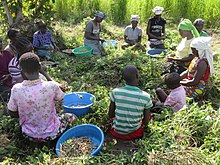| History of Uganda | ||||||||||||||
|---|---|---|---|---|---|---|---|---|---|---|---|---|---|---|
 | ||||||||||||||
| Chronology | ||||||||||||||
|
||||||||||||||
| Special themes | ||||||||||||||
|
||||||||||||||
| By topic | ||||||||||||||
|
| ||||||||||||||

Since precolonial times, Peasant agricultural production has been the predominant economic activity in the landlocked country of Uganda in East Africa.[1] Despite an active trade in ivory and animal hides linking Uganda with the east coast of Africa long before the arrival of Europeans, most Ugandans were subsistence farmers.[1]
After declaring Uganda a protectorate in 1893, Britain pursued economic policies that drew Uganda into the world economy primarily to serve Britain's late-19th-century textile industry.[1] Cotton cultivation increased in importance after 1904, and once it became clear that cotton plantations would be too difficult and expensive to maintain, official policy encouraged smallholder farmers to produce and market their cotton through local cooperative associations.[1]

By 1910 cotton had become Uganda's leading export.[1] In the following decades, the government encouraged the growth of sugar and tea plantations.[1] Following World War II, officials introduced coffee cultivation to bolster declining export revenues, and coffee soon earned more than half of Uganda's export earnings.[1] When coffee replaced cotton as Uganda's principal export in the 1950s, it was still produced in the pattern of small peasant holdings and local marketing associations that had arisen early in the century.[2]
The economy registered substantial growth, but almost all real growth was in agriculture, centered in the southern provinces.[2] The fledgling industrial sector, which emphasized food processing for export, also increased its contribution as a result of the expansion of agriculture.[2]
Growth slowed in the late 1950s, as fluctuating world market conditions reduced export earnings and Uganda experienced the political pressures of growing nationalist movements that swept much of Africa.[2] Uganda enjoyed a strong and stable economy in the years approaching independence.[1] Agriculture was the dominant activity, but the expanding manufacturing sector appeared capable of increasing its contribution to gross domestic product (GDP), especially through the production of foodstuffs and textiles.[1] Some valuable minerals, notably copper, had been discovered, and water power resources were substantial.[1]
Since 1990 the Ugandan economy has shown more growth; real gross domestic product (GDP) grew at an average of 6.7% annually during the period 1990–2015,[3] whereas real GDP per capita grew at 3.3% per annum during the same period.[3] Over the same period the share of agriculture value added in GDP declined from 56% in 1990 to 24% in 2015; the share of industry grew from 11% to 20% (with manufacturing increasing at a slower pace, from 6% to 9% of GDP); and the share of services went from 32% to 55%.[3]